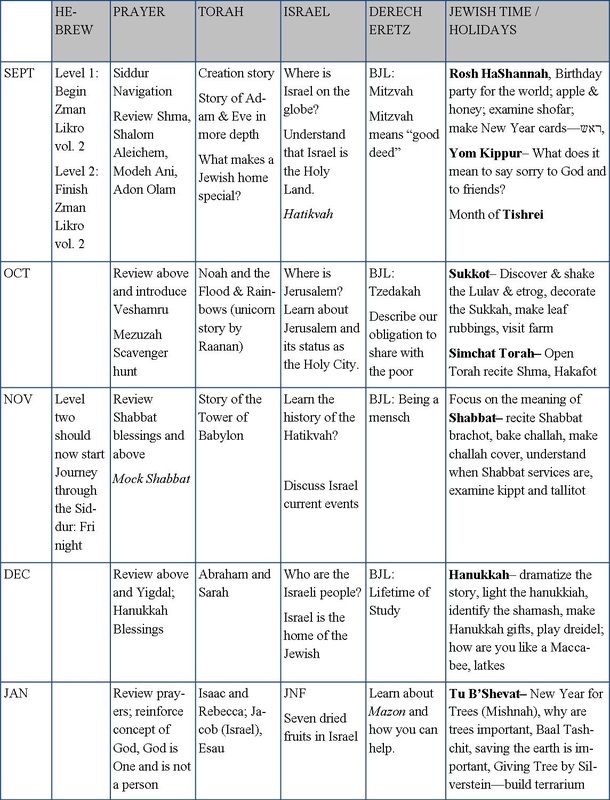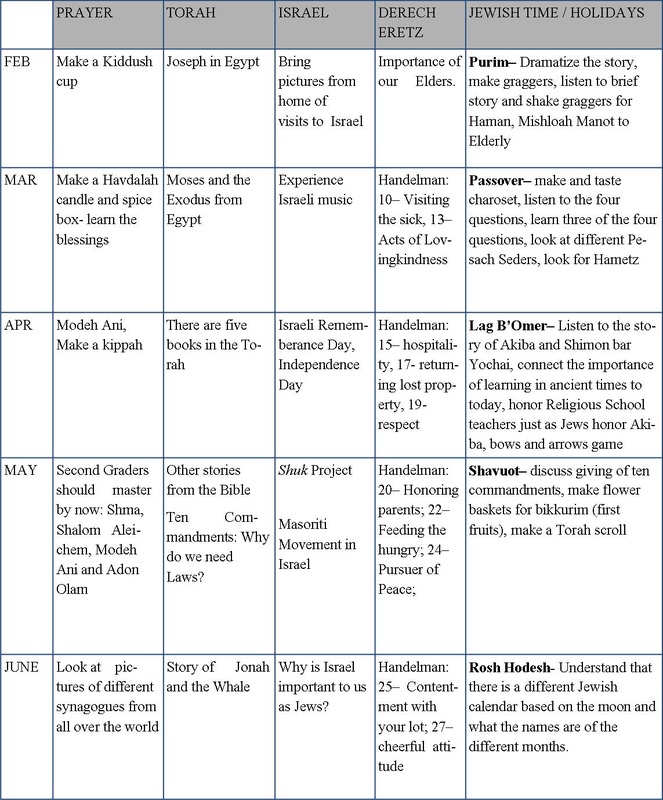TT-Bet
TT - Bet Class (Grades 4-5)
Since it has been some time since there has been structured learning of Hebrew at JCM, we will start from the beginning with the letters and advance at a quicker pace than the Aleph class. We will go through the Zman Likro curriculum at the beginning. I am of the belief that the Hebrew learning in this class will be very conducive for a Hevruta (partner/diad) clock learning style where partners at the same level can work together and at specific guided times, the stronger students can help those who are just starting in this class.
Students will widen their overall understanding of why Hebrew is such an important part of the Jewish people. This can be done by looking at the history and life of Eliezer ben Yehudah.
The Zman Likro curriculum introduces formal Hebrew language instruction (i.e. vocabulary, grammar, sentence structure, conjugation, verbs, nouns, masculine, feminine, etc.).
Prayer
This is the first class where students will be leading Friday night services. This is and should be seen as a great accomplishment.
Judaic Studies
This year students will learn how to study Jewish texts in Hevruta (dyads). As they become used to this learning style, the teacher will be fully attentive to the different groups and their needs. Thankfully, there are numerous tools for teaching Torah to this age group such as, A Child’s Bible. The Teacher’s Guide makes it useful and accessible to the different students. This book has sections called, what does it mean, and what does it teach? This is a great introduction to drawing out meaning from the text.
Ethics and Morals
Being the first year of the new curriculum, the BJL can be used to introduce the important terms having to do with Jewish ethics and morality. To make it age appropriate, each BJL should be combined with a text from Handelman’s Vision for Conservative Early Childhood Programs section on Ethical Behavior. The Hevruta method should be used with questions relating to the text that are age appropriate.
This class will focus on the topics of: visiting the sick, acts of lovingkindness, hospitality, returning lost property, respect, honoring parents, feeding the hungry, being a pursuer of peace, contentment with your lot and having a cheerful attitude. Should there be additional time, the rest of the ethical values can be looked at through the corresponding stories. The enduring goals should be the students’ ability to discuss the importance of respecting other people in our society as a Jewish value and what it means to be aware of the need to maintain relationships through the model of בין אדם למקום (between human and the Eternal) and בין אדם לחברו (between people).
Holidays
Our goal by the end of this class is for the vocabulary of the holidays to be recognizable. Central themes of the holidays should be reinforced with quotes from the Torah. For example, identifying what the Shofar is and its place in Judaism is attainable for this age. Goodman’s book, Teaching Jewish Holidays, can be used to increase the content of the class.
Israel
Now that students have been introduced to Israel they are now ready to understand why the Jewish people attribute a holiness to the land. This will allow them to then understand the importance that we attribute to Jerusalem, the eternal capital of the Jewish people. Knowing that the State of Israel has preserved the rights of all religions to worship in Jerusalem is important. They will learn that there was once a Temple and the only remaining piece is the outer wall of the Second Temple. Students should hear the Hatikvah and be able to recite it. Students will also learn some of the differences between Israel and Canada in terms of geography, history and culture. Students will understand that Israel is home to many different cultures and denominations within Judaism.
Mon, November 24 2025
4 Kislev 5786
Link for all JCM ZOOM events and services:
https://us02web.zoom.us/j/5284619173?pwd=T0p6c3p0WVdySmt0czJOZGhzRnhEUT09
Meeting ID: 528 461 9173
Passcode: 1818
Phone Dial In: 17193594580
Code: 5284619173#
Passcode: 1818#
Update this content.
Maui Jews Newsletter
Correction: Yahrzeits for week of Sept 21st-27th
Thursday, Sep 25 11:07pmIn our last newsletter the Yahrzeit dates & names
included were for the previous week.
The correct names (z”l) for the week of
Se
Kabbalat Shabbat tomorrow - come join us!
Thursday, Sep 25 5:00pmIt was so special to be together for Rosh Hashanah —
whether you joined us in person or were celebrating from afar, you are a part of
High Holidays, Foodland Give Aloha, Message from our Board President
Thursday, Sep 18 2:14pmAs we welcome the New Year together, I want to personally invite you to join us for Rosh Hashanah. This is a time for renewal, reflectio
Find Us!
Address:
634 Alulike Street
Kihei, HI 96753
CLICK HERE for directions
Office Hours vary and visits are available by appointment.
Feel free to contact us anytime by email or phone.
Phone: 808-874-5397
Email: jcmmauijews@gmail.com
Get Our Newsletter
Click below to receive our newsletter and stay up to date on everything that is happening at JCM!
Friday Night
| Candle Lighting : 5:26pm |
Shabbat Day
| Perwin Bat Mitzvah : 9:00am |
| Perwin Bat Mitzvah : 9:00am |
| Havdalah : 6:34pm |
jcmmauijews@gmail.com
808-874-5397
Board of Directors
President:
Jessica Pearl
Vice President:
Mitch Berman
Treasurer:
Joshua Kalkstein
Secretary:
Nicole Lasko
Directors:
Joel Richman
Sandra Rogers
Sam Shnider
Stephanie Malleck
Mission
The mission of the Jewish Congregation of Maui is to support and inspire Jewish religious and cultural practices for Maui residents and visitors, provide and encourage Jewish education and life cycle services, and engage the Jewish community with religious services, classes, and events.
Update this content.
Jewish Congregation of Maui
Beit Shalom Synagogue
634 Alulike Street
Kihei, HI 96753
808-874-5397
Privacy Settings | Privacy Policy | Member Terms
©2025 All rights reserved. Find out more about ShulCloud


